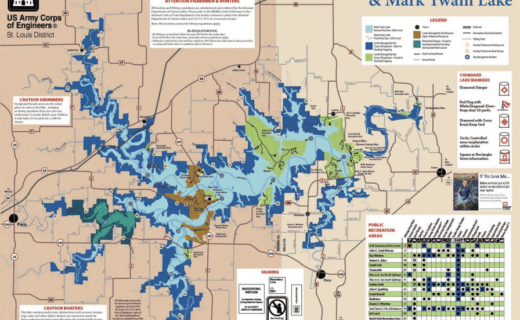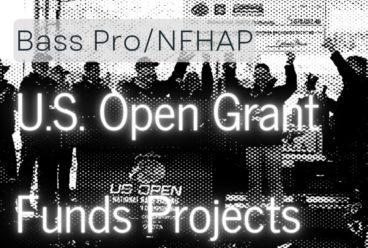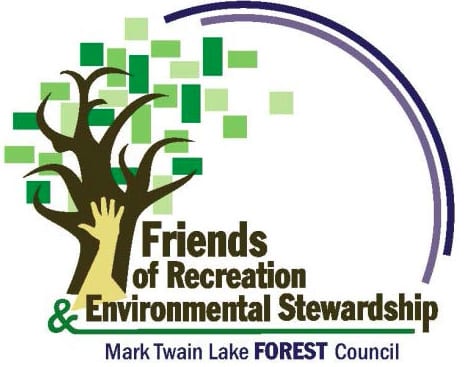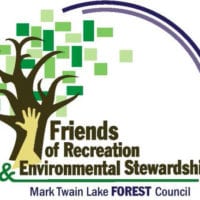Overview
-
Status
Ongoing -
Estimated Completion
2024 -
Location
Mark Twain Lake, Missouri -
Grants Received
$19,204 -
Total Budget
$55,000 -
Friends Group
MTL FOREST Council -
Partners
Missouri Department of Conservation, U.S. Army Corps of Engineers
Mark Twain Lake, built in 1984, is a U.S. Army Corps of Engineers project authorized for flood risk management in the Salt River Basin, hydroelectric power generation, water supply, fish and wildlife conservation, recreation, and incidental navigation support to the Mississippi River system. At normal pool, the reservoir provides 18,600 acres of warm water fisheries habitat. The reservoir has progressed through the natural maturation process associated with man made impoundments. The standing timber is deteriorating, and the underwater structure it creates is diminishing. This results in impacts to aquatic invertebrate populations, species recruitment, and protective habitat. The project will place 100 4’x4’x4′ MTL Fish Cubes, 150 Spider Blocks, and 150 Porcupine Cribs in the basin of the reservoir based on strategic habitat requirements. 63 reservoir acres will be addressed with this project. This proposal is on a small, but impactful scale, address the loss of structural habitat, create appealing shoreline access to the management unit, and encourage increased recreational angling opportunities.
Why It Matters

Mark Twain Lake is a popular recreation destination providing excellent opportunities for quality outdoor experiences. The lake annually welcomes over one million visitors, and offers recreational opportunities such as full-service camping, hiking, hunting, pleasure boating, and swimming. The sustainable fisheries resource though is naturally the most popular recreation pursuit of the visitors of Mark Twain Lake. The diversity of inundated topography, water depth, and underwater structure supports varying angling experiences. The reservoir though is subject to the common challenges of water resource impoundments: natural reservoir aging process, shoreline topography limitations, and the operational requirements of a multi-purpose civil works reservoir. These factors impact the sustainable fisheries and the quality of recreational angling opportunities at Mark Twain Lake.
During initial development of the reservoir, a unique management strategy was implemented in the basin that differed from traditional methods employed by Corps of Engineers at civil works projects. Instead of clearing the entire basin, standing timber was retained in the tributaries and associated flood plains to provide aquatic structure. The resulting management strategy created an environment that supported a strong, sustainable and vibrant fisheries that has been enjoyed by anglers since 1984. The reservoir, though, has progressed through the natural maturation process associated with man-made impoundments. The standing timber is deteriorating, and the underwater structure it creates is diminishing. (See Figure 1) This results in impacts to aquatic invertebrate populations, species recruitment, and protective habitat.
Threats
The authorized operational requirements of Clarence Cannon Dam and Mark Twain Lake create unique challenges to fisheries management. The flood risk mission obligates the reservoir to sustain elevated pool levels during seasonal rain events. The reservoir also serves as a water source to support a hydro-electric power mission, which requires substantial outflows in order to meet the demands of the power distribution infrastructure. Both factors contribute to a pool elevation that fluctuates 50 feet in the reservoir basin. The cyclic nature of these operations contributes to an environment conducive to the structural degradation of shoreline and submerged habitat.
Authorized by the Flood Control Act of 28 June 1938, Clarence Cannon Dam and Mark Twain Lake is a U.S. Army Corps of Engineers civil works project located in Northeast Missouri. Its authorized purposes are for flood risk management in the Salt River Basin, hydroelectric power generation, water supply, fish and wildlife conservation, recreation, and incidental navigation support to the Mississippi River system. The dam and associated reservoir began full operation in 1984.
Clarence Cannon Dam was developed on the Salt River system, approximately 63 miles upstream from its confluence with the Mississippi River. The public lands and waters of Mark Twain Lake occupies 54,741 acres within Ralls and Monroe County, Missouri. At normal pool, the reservoir provides 18,600 acres of warm water fisheries habitat. The associated watershed of Mark Twain Lake is comprised of 2,318 square miles of lands primarily in agricultural production.
The topography of an impounded river valley poses challenges for shoreline fishing access. The Salt River Basin is characterized by broad impounded river bottoms with steep to near vertical hillsides that form the perimeter shoreline. Conditions are ideal for fisherman utilizing boats in pursuit of their angling experience but does not lend itself to land-based shoreline fishing access. Though not prevalent at the lake, there are locations that are traditionally used for this purpose. The lack of developed access, combined with the loss of submerged habitat does not project an attractive opportunity to the vast majority of the demographic seeking this recreational opportunity.
Though Mark Twain Lake has sustained a strong and viable fishery, the decline in structural underwater and shoreline habitat, and the limited shoreline access is contributing to an environment not proactive to the pursuit of recreational angling. This proposal will on a small, but impactful scale, address the loss of structural habitat, create appealing shoreline access to the management unit, and encourage increased recreational angling opportunities.
What FOR Is Doing
Natural resource professionals from U.S. Army Corps of Engineers and the Missouri Department of Conservation, recreational anglers, and community members formed an action group in 2020, and have collaborated to develop a long-term fisheries habitat management plan for Mark Twain Lake. The group assessed lake conditions, existing natural habitat structure, capabilities of independent entities, available resources, and alignment of long-term goals to establish a five-year management plan for the development of fisheries habitat. Since 2021, this group has successfully established artificial habitat structure at four areas of the lake encompassing 105 reservoir acres and improved the recreational angling opportunities in the affected areas.
There are two distinct goals of this proposed project. The first goal is to continue development of artificial fish habitat structure that will replace what has deteriorated through the natural maturation process of the reservoir, or through the authorized operational requirements imposed upon the reservoir. Proposed is the installation of artificial structural components at a location to restore approximately 35 acres of underwater fisheries habitat, and directly support recreational angling opportunities. The structures will be constructed of materials providing long-term durability, capable of withstanding the stresses of submerged and dry environments and designed to reduce snagging of traditional fishing tackle and equipment. The structures will be placed at differing elevations in the basin of reservoir in a pattern to provide for stability and integrity of development. Furthermore, this project proposes the development of direct shoreline access to the restoration site which will appeal to a broad demographic spectrum, including families, youth, senior citizens, and novice anglers. Though designed and placed as a shoreline fishing resource, the developed site will still be accessible to anglers conveying by boat.
The second goal supports the recruitment and retention of sport fisheries species through the development of littoral zone habitat. Loss of natural structure through the normal maturation of the reservoir has had a definitive impact on its capability to sustain resilient and stable populations of the traditional sports fish that are sought by the angling community. This project proposes developing and placing littoral structures that will directly complement traditional spawning areas of the lake, providing escape and nursery cover for juvenile fish. Area encompassed in the project will be 28 reservoir acres. Execution involves saturating the basin of coves with vertical littoral habitat structure, constructed of hardwood materials, and designed to provide protected interior space. These structures will be placed adjacent to slopes possessing the ideal rocky substrate favored for spawning by many of the fish species of the lake. Though placement of the littoral zone habitat will be habitat-driven, the support to recreational fishing will be realized when the recruitment class matures to a size contributing to the sustainable population present in the reservoir.
Methods
Under this plan, locations for the fish habitat structures are determined utilizing the following criteria:
a. Gradual slope or grade
b. Proximity to existing available parking and shoreline access
c. Lack of habitat structure, or subject to rapid degradation
d. Larger coves or bays with multiple inlets
e. Not exposed to current
f. Not located in traditional boat travel routes
g. Sheltered to secure integrity of habitat development
Under this plan, locations for the littoral zone habitat structures are determined utilizing the following criteria:
a. Gradual slope or grade
b. Adjacent to rocky slopes
c. Lack of habitat structure
d. Not exposed to current
e. Not located in traditional boat travel routes
f. Sheltered to secure integrity of habitat development
The habitat structures proposed for development of this habitat restoration project will include the following:
a. Mark Twain Lake Cubes – 100 “MTL Cubes” will be constructed for placement at the restoration site. Each cube will measure 4 feet height, 4 feet in width, and 4 feet in breadth. The cubes are constructed of 1 ½ inch PVC pipe and are intertwined with 100 feet of 4 inch drain tile tubing. The cubes are designed to standards proven to be extremely effective in similar reservoir environments. Reference Figure 5. The design utilized at Mark Twain Lake accommodates species of game fish that suspend in differing depths, and to provide habitat at varying lake levels. These structures are placed in mass at deeper depths. Structures are weighted with sand/gravel mixed placed on the interior of the pipe components.
b. Spider Blocks – 150 Spider Blocks will be constructed for placement at the restoration site. A standard 9” x 9” x 15”, dual cavity concrete block serves as the foundation of the feature. Concrete is placed in the cavities to secure ½ inch flexible irrigation tube serving as habitat structure. Reference Figure 5. These structures are distributed in mass at shallow depths in proximity to the shoreline providing littoral zone habitat favored by certain species of game fish, while also providing accessibility to shoreline fishing and vessel-oriented angling experiences.
c. MTL Porcupine Cribs – 150 MTL Porcupine Cribs will be constructed for placement at a designated littoral zone restoration site. Averaging three feet in height, and constructed of hardwood materials, the structures are based on proven designs implemented at reservoirs addressing similar conditions that are present at Mark Twain Lake. These structures will be distributed in mass in the basin of a cove that possess adjacent rocky slopes.
As currently being demonstrated in on-going management efforts associated with the Mark Twain Lake Fisheries Habitat Project, structure development activities occur in four distinct phases as outlined in the following:
a. Determination of management areas through collaboration with associated partners in accordance with standards established by the collective – 14 days
b. Trail Access Development – Construct native surfaced trails providing access from established parking locations to specified shoreline location. Timeframe – 10 days
c. Habitat Structure Construction – Procure the required resources, and assemble the 100 MTL Cubes, 150 Spider Blocks, and 150 Porcupine cribs. Timeframe – 60 days
d. Installation – Transport the habitat components to the designated development areas, coordinate vessels and labor with collaborating partners, and install the structures. Timeframe 30 days.
Monitoring Plan
Monitoring the performance of this project will be a multi-faceted process.
a. Periodic maintenance of the trail system and access areas are required to retain a safe and appealing facility.
b. Missouri Department of Conservation will monitor the sites for population vitality through traditional scientific processes.
c. Sonar scans will be performed on the sites to monitor the integrity of the installed structures.
d. Public feedback through customer surveys and social media outlets to monitor visitor use, visitor perception, and incorporate suggested facility improvements deemed appropriate for the facility.
Outreach Plan
Public outreach and education are an important component of this project. Our plan to communicate the project to the public is provided in the following:
a. Develop a single page printed map, easily re-produced, and easily modified, that incorporates the location of existing and proposed development sites. Maps are available in printable forms, and digital downloads through various partner websites.
b. Continue a contribution/involvement program (eg. Cabins for Crappies) where community members and organizations are engaged to support on-going habitat initiatives. To date, the established program has yielded $1500.00 in community contributed funds.
c. Communication through available Corps of Engineers’ social media outlets, and through available communication outlets of associated partners.
Related News

FY2024 Projects Submitted to Secretary of Interior
We happy to announce that seven FY2024 grants from Friends of Reservoirs members were submitted as part of the package to the Secretary of Interior! Expansion of North Carolina Wildlife […]

Bass Pro Shops/National Fish Habitat Partnership U.S. Open Grant Program Funds Nine Projects in 2022
(Washington, DC) - The National Fish Habitat Partnership (NFHP) announced today nine projects funded through a nearly $1.6 million grant program established through proceeds from the Bass Pro Shops U.S. Open […]
Donate Today
to support similar habitat projects
Green Sponsors
Silver Sponsor
- Missouri Department of Conservation




